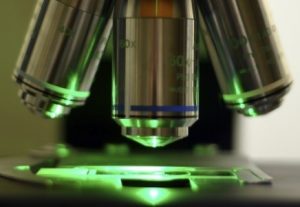Live-Cell 3D Imaging with Fluorescence Nanoscopy
Advances in microscopy techniques now allow for ultra-high-resolution imaging of fluorescently labeled markers within living three-dimensional (3D) cell cultures. This provides researchers with a more accurate spatial visualization of cell-to-cell interactions, sub-cellular structures, and protein assemblies without significantly affecting cell viability. Here we review the history of and applications for fluorescence-based 3D live-cell imaging.
A brief history
Fluorescence microscopy first allowed for the sub-cellular localization of specifically labeled proteins. However, conventional light microscopy was physically limited by diffraction to 180 nm in the focal plane and to 500 nm along the optic axis. Additional techniques were developed to overcome this constraint and achieve “diffraction-unlimited” resolution. These included using interference and structured light methods improved spatial resolution to ~100 nm resolution, and further non-linear methods could provide ~30 nm resolution. The development of 3D cell culturing systems offered researchers a new tool for studying cells within a more biologically relevant context. However, traditional confocal microscopy techniques were often poorly suited for penetrating thick, light-scattering 3D cell cultures beyond 100 µm. Furthermore, fluorescence microscopy often requires the use of lethal doses of photo-toxic UV light during the imaging process. These limitations left researchers in need of new methods for higher resolution cell imaging that could be performed non-invasively, within physiological conditions.
Fluorescence Nanoscopy
Fluorescence nanoscopy, also known as super-resolution microscopy, refers to a wide collection of techniques for fluorescence imaging at nanoscale (2 to 25 nm) resolutions. Many of these methods also provide for penetrative detection and minimally invasive imaging, so imaged 3D cell samples can be kept viable for study over time. Some examples of current fluorescence-based nanoscopy techniques include light-sheet, stimulated emission depletion (STED), multiphoton microscopy, stochastic reconstruction microscopy (STORM) , fluorescence photoactivation localization microscopy (FPALM), photobleaching, asynchronous localization of photoswitching emitters, and optical coherence microscopy (OCM) combined with confocal fluorescence microscopy.
Applications
The combination of highly specific fluorescent marker detection with ultra-high-resolution analysis in living 3D cell samples offers a powerful tool for researchers to better understand complex cell biology. While it is not possible to list all the possible applications for fluorescence nanoscopy, examples include studies of cellular structures, membrane organization, dynamic assembly of proteins, neurobiology, and virology. STED techniques are also being used for neuronal cell imaging, in studies investigating the cell membrane formation, and in studies on nanoscale structure and dynamics of lipid-protein interactions. A research team at the University of Washington is even using fluorescent nanoscopy to perform sub-micron resolution 3D imaging of cells within intact human and rodent tissue samples. Selecting the optimal combination of fluorochromes for your experiments is more important than ever for super-resolution microscopy applications. These applications often require long exposure times, so selecting fluorochromes that are resistant to photobleaching is key. Additionally, brightness and a high contrast ratio between excited and non-excited states of the fluorochrome are top considerations when designing your experiment. Abberior dyes and Atto dyes have been developed and tested specifically with super-resolution microscopy techniques and have many desirable qualities for the application. Alexa Fluor dyes are useful in these applications due to their high degree of photostability and brightness. Qdots and numerous fluorescent proteins have also been used with great success in super-resolution applications. Planning a fluorescent microscopy or nanoscopy experiment? Search these fluorochromes and 800 more on FluoroFinder’s Spectra Viewer to find the antibody-dye combination you are looking for.





